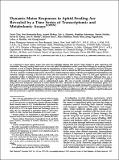Por favor, use este identificador para citar o enlazar a este item:
http://hdl.handle.net/10261/343568COMPARTIR / EXPORTAR:
 SHARE SHARE
 CORE
BASE CORE
BASE
|
|
| Visualizar otros formatos: MARC | Dublin Core | RDF | ORE | MODS | METS | DIDL | DATACITE | |

| Título: | Dynamic Maize Responses to Aphid Feeding Are Revealed by a Time Series of Transcriptomic and Metabolomic Assays |
Autor: | Tzin, Vered; Fernández-Pozo, Noé CSIC ORCID ; Richter, Annett; Schmelz, Eric A.; Schoettner, Matthias; Schäfer, Martin; Ahern, Kevin R.; Meihls, Lisa N.; Kaur, Harleen; Huffaker, Alisa; Mori, Naoki; Degenhardt, Joerg; Mueller, Lukas A.; Jander, Georg | Fecha de publicación: | 16-sep-2015 | Resumen: | As a response to insect attack, maize (Zea mays) has inducible defenses that involve large changes in gene expression and metabolism. Piercing/sucking insects such as corn leaf aphid (Rhopalosiphum maidis) cause direct damage by acquiring phloem nutrients as well as indirect damage through the transmission of plant viruses. To elucidate the metabolic processes and gene expression changes involved in maize responses to aphid attack, leaves of inbred line B73 were infested with corn leaf aphids for 2 to 96 h. Analysis of infested maize leaves showed two distinct response phases, with the most significant transcriptional and metabolic changes occurring in the first few hours after the initiation of aphid feeding. After 4 d, both gene expression and metabolite profiles of aphid-infested maize reverted to being more similar to those of control plants. Although there was a predominant effect of salicylic acid regulation, gene expression changes also indicated prolonged induction of oxylipins, although not necessarily jasmonic acid, in aphid-infested maize. The role of specific metabolic pathways was confirmed using Dissociator transposon insertions in maize inbred line W22. Mutations in three benzoxazinoid biosynthesis genes, Bx1, Bx2, and Bx6, increased aphid reproduction. In contrast, progeny production was greatly decreased by a transposon insertion in the single W22 homolog of the previously uncharacterized B73 terpene synthases TPS2 and TPS3. Together, these results show that maize leaves shift to implementation of physical and chemical defenses within hours after the initiation of aphid feeding and that the production of specific metabolites can have major effects in maize-aphid interactions. | URI: | http://hdl.handle.net/10261/343568 | DOI: | 10.1104/pp.15.01039 | ISSN: | 0032-0889 |
| Aparece en las colecciones: | (IHSM) Artículos |
Ficheros en este ítem:
| Fichero | Descripción | Tamaño | Formato | |
|---|---|---|---|---|
| Tzin_Plant_phys_2015_maize.pdf | Maize aphid feeding paper | 2,07 MB | Adobe PDF |  Visualizar/Abrir |
CORE Recommender
PubMed Central
Citations
65
checked on 03-may-2024
SCOPUSTM
Citations
121
checked on 14-may-2024
WEB OF SCIENCETM
Citations
112
checked on 24-feb-2024
Page view(s)
14
checked on 19-may-2024
Download(s)
7
checked on 19-may-2024
Google ScholarTM
Check
Altmetric
Altmetric
Artículos relacionados:
NOTA: Los ítems de Digital.CSIC están protegidos por copyright, con todos los derechos reservados, a menos que se indique lo contrario.
